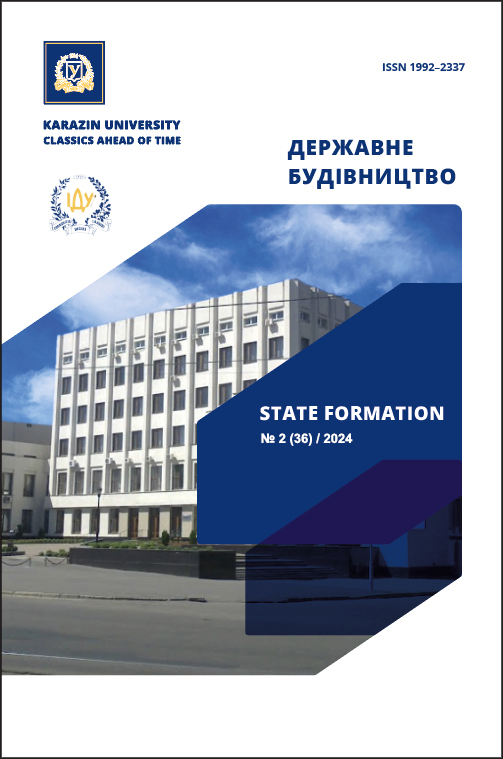The Impact of Digitalization and the Introduction of Electronic Public Registers on Organizational Culture and Public Administration in Ukraine’s Judiciary.
Abstract
This article explores the impact of digitalization and the introduction of electronic public registers on the organizational culture and public administration within Ukraine’s judiciary. The authors analyze key challenges of digital transformation, including insufficient IT infrastructure, low levels of digital competence among judges and court personnel, and the judiciary’s traditional cultural closedness. The study underscores the necessity of integrating technical innovations with value-based changes to transition from a bureaucratic to a service-oriented justice model. The paper examines international best practices in judicial transformation, with insights from the Netherlands, Finland, Denmark, and post-conflict nations in the 21st century. Key methodological approaches are identified, such as developing comprehensive digitalization strategies, emphasizing user-centric design, encouraging grassroots judicial initiatives, and fostering "soft skills" among judges. The authors emphasize that digitalization must be accompanied by the formation of a new organizational culture grounded in transparency, accountability, user orientation, and openness to innovation.
Practical recommendations for the effective transformation of Ukraine’s judiciary include simplifying and digitalizing basic court services, implementing user-friendly electronic registers, establishing interdisciplinary change management teams within courts, and supporting volunteer-driven initiatives to develop innovative solutions. The study places particular emphasis on the need for a comprehensive digital transformation strategy that integrates technological, procedural, and cultural reforms. The authors argue that the introduction of electronic public registers is not merely a tool for judicial optimization but a powerful driver for renewing organizational culture. This transformation is critical for rebuilding public trust in the judiciary, ensuring the rule of law, and creating a favorable environment for Ukraine’s post-war recovery.
Downloads
References
Ibishevic, H. (2024, February 17). The experience of Bosnia and Herzegovina can serve as a valuable lesson for Ukraine. Ukrainian Radio. URL: https://ukr.radio/
news.html?newsID=103488 [in Ukrainian].
Loginova, N. (2021). E-justice in Ukraine: Problems and development prospects. Legal Scientific Electronic Journal, (2), 86–89. DOI: https://doi.org/10.32782/2524-0374/2021-2/20
[in Ukrainian].
USAID New Justice Program. (2017). Rule of Law Yardstick. Commentary and Glossary. Kyiv: USAID New Justice Program.
Cabinet of Ministers of Ukraine. (2015). Regulation on data sets to be published in the form of open data: Resolution No. 835, October 21, 2015. URL: https://zakon.rada.gov.ua/laws/
show/835-2015-%D0%BF#Tex t [in Ukrainian].
Law of Ukraine. (1994). On information protection in information and communication systems: No. 80/94-VR, July 5, 1994 (amended as of June 28, 2024, under No. 3783-IX). URL: https://zakon.rada.gov.ua/laws/show/80/94-%D0%B2%D1%80#Text [in Ukrainian].
Tkachuk, V. (2018). Citizens’ impressions of the judicial system are based on how elementary issues are resolved. Law and Business. URL: https://zib.com.ua/ua/132692.html
[in Ukrainian].
Dejure. (2023). How the Ukrainian judicial system works during the war. Kyiv: Dejure. URL: https://dejure.foundation/vsoov6dhy1-yak-ukranska-sudova-sistema-pratsyu-pd-c/
[in Ukrainian].
Yakovleva, V.S. (2023). Criminological characteristics and prevention of interference in the activities of judicial bodies: Ph.D. thesis, 081 - Law. Kharkiv. URL: http://surl.li/gsjovb
[in Ukrainian].
European Commission. (2020). Digitalisation of justice in the European Union: A toolbox of opportunities (COM/2020/710 final). Brussels: European Commission. URL: https://eur-lex.europa.eu/legal-content/EN/ALL/?uri=COM:2020:710:FIN
European judicial systems: CEPEJ Evaluation Report. Evaluation cycle (2020 data): Part 1: Tables, graphs, and analyses. (2020). Council of Europe. URL: https://rm.coe.int/rapport-evaluation-partie-1-francais/16809fc058
Gøtze, M. (2016). The Danish Court Administration. In P. H. Russell & K. Malleson (Eds.). Appointing Judges in an Age of Judicial Power: Critical Perspectives from Around the World, 144–156. University of Toronto Press.
Hirvonen, M. (2021). Digitalization in the Finnish courts: COVID-19 as a catalyst. S. Gless & F. Gremaud (Eds.). Courts and Artificial Intelligence, 117–134. Springer. DOI: https://doi.org/10.1007/978-94-6265-472-6_7
Mak, E. (2017). The T-shaped lawyer and beyond: Rethinking legal professionalism and legal education for contemporary societies. URL: https://www.researchgate.net/publication/331022253_ nThe_T-shaped_Lawyer_and_Beyond_Rethinking_legal_professionalism_and_legal_education_for_ contemporary_societies
OSCE Office for Democratic Institutions and Human Rights. (2022). Interim report (18 October – 2 November 2022). URL: https://www.osce.org/files/f/documents/e/7/530503.pdf
Sereda, O., Mamnitskyi, V., Kornieva, P., & Cherevatenko, I. (2024). New steps of digitalisation of civil justice in Ukraine. Case study. Access to Justice in Eastern Europe, 7(1), 416–426. DOI: https://doi.org/10.33327/AJEE-18-7.1-n000118 URL: https://ajee-journal.com/upload/ attaches/att_1706999517.pdf
OSCE. (2019). The contribution of the OSCE to the rule of law in Ukraine. URL: https://www.osce.org/project-coordinator-in-ukraine/441381
Van den Hoogen, R. (2020). Will digitization lead to better justice in the Netherlands? In M. Weller & M. Wendland (Eds.). Digital Single Market. The Influence of Technology on Law, 39–52. Springer. DOI: https://doi.org/10.1007/978-3-030-54455-3_4
World Bank. (2020). Worldwide governance indicators. Washington, D.C.: World Bank. URL: https://info.worldbank.org/governance/wgi/

